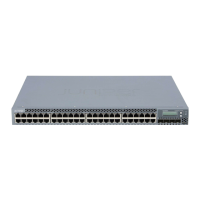NOTE: Thefollowingprocedureuses Hayes-compatible-modemcommands
to configure the modem. If your modem is not Hayes-compatible, see the
documentation for your modem for the equivalent modem commands.
To configure the modem:
1. Connect the modem to the desktop or notebook computer.
2. Power on the modem.
3. From the computer, start your asynchronous terminal emulation application (such
as Microsoft Windows HyperTerminal) and select the COM port to which the modem
is connected (for example, COM1).
4. Configure the port settings shown in Table 28 on page 101.
Table 28: Port Settings
ValuePort Settings
115200Bits per second
8Data bits
NoneParity
1Stop bits
NoneFlow control
5. In the HyperTerminal window, type at. Press Enter.
The modem sends an OK response to verify that it can communicate successfully
with the COM port on your desktop or notebook computer.
6. To configure the modem to answer a call on the first ring, type ats0=1 at the prompt.
Press Enter.
7. To configure the modem to accept modem-control DTR signals, type at&d1 at the
prompt. Press Enter.
8. To disable flow control on the modem, type at&k0 at the prompt. Press Enter.
9. To set the fixed serial port speed on the modem, type at&b1 at the prompt. Press
Enter.
NOTE: You must set the serial port to the fixed speed so that the modem
will not adjust the serial port speed to the negotiated line speed.
10. To save the new modem settings, type at&w0 at the prompt. Press Enter.
101Copyright © 2011, Juniper Networks, Inc.
Chapter 11: Connecting the Switch

